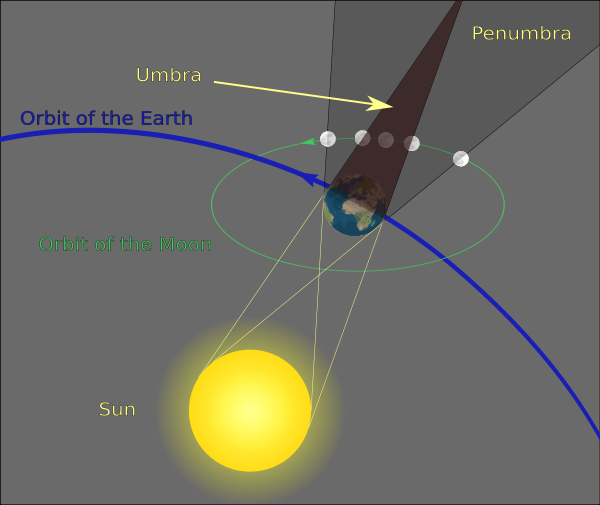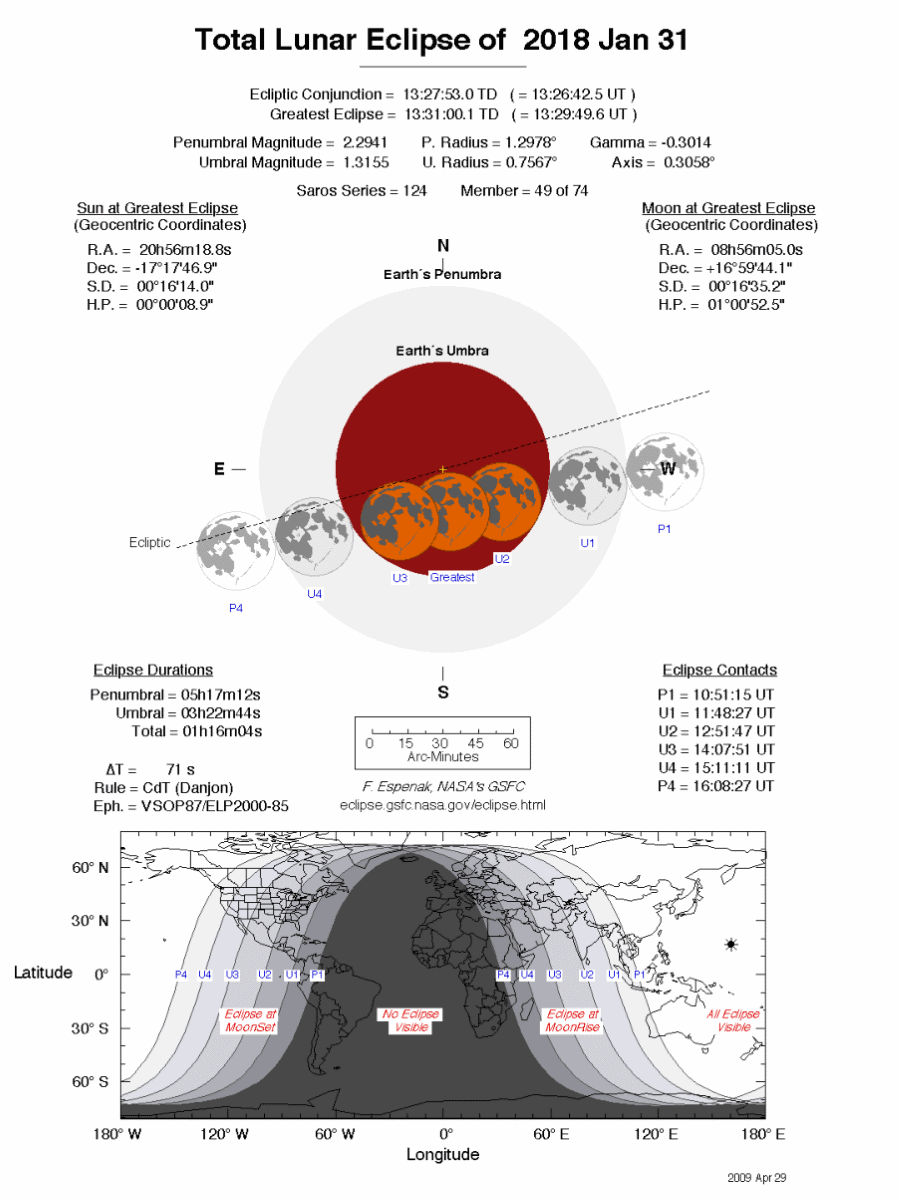Astronomical Info / 天文資訊 > Special Events / 特別項目 > Total Lunar Eclipse of January 31st, 2018 | 2018 年 1 月 31 日之月全食 [Refresh 更新]
Quick info 快速資訊: Eclipse time (total and partial phases) at Hong Kong 香港可見月食 (全、偏食) 時間 : 2018/01/31 19:48 - 23:11 HKT
Quick links 快速連結:| - Live webcast 網上直播 | - Information about the eclipse 是次月食資料 |
| - Local (HK) circumstances 本地 (香港) 情況 | - Future lunar eclipses 未來月食 |
| - Lunar eclipse basic knowledge 月食基礎知識 | - More eclipse info 更多日月食資訊 |
 Live webcast 網上直播 Live webcast 網上直播 |
Please click on the links below for live webcast and descriptions of the event. All links (on the left panel) redirect you to external websites and open in new windows.
請按下列連結以觀看網上直播及相關資訊。所有 (左方) 連結連至第三者網站並以新視窗開啟。
| Provider 提供者 | Channel / Notes 頻道 / 備註 |
| - HKO and others 香港天文台與其他機構 | |
| - Weathernews Japan 日本 Weathernews | |
| - Taipei Astronomical Museum 台北天文館 | |
| - Slooh.com | |
| - Virtual Telescope | |
| - NASA Live |
 Information about the eclipse 是次月食資料 Information about the eclipse 是次月食資料 |
This is the first total eclipse of the moon since September 2015. Totality will be visible in its entirety in eastern Asia, most of Oceania and northwestern North America. Eastern Africa, eastern Europe and western/central Asia will experience the event at moonrise, while observers in most of North America will see the eclipse at moonset. The eclipse is not visible at all in most of South America, western Europe and western Africa.
The total phase will last more than 1 hour while the partial phase extends the eclipse by another hour before and after the total phase. As the moon just reached perigee on January 30, it will appear slightly bigger than normal during this eclipse.
這是自 2015 年 9 月以來的首次月全食。東亞、大洋洲大部分地區及北美洲西北部將可見整個月食過程;東非、東歐及中西亞將見帶食月出,而北美洲大部分地區則見帶食月落。是次月食於南美洲大部分地區、西歐及西非並不可見。
全食階段歷時超過 1 小時,而偏食則於全食前後各 1 小時間可見。由於月球於 1 月 30 日剛通過近地點,是次月食中月球將顯得比正常稍大。
|
Map courtesy of NASA
月食圖由美國太空總署提供 |
The following shows some general details about the eclipse:
下表列出是次月食的一般性資料 :
All places that can observe this eclipse (no matter what the Moon's position is) will experience the aforementioned events in the times indicated above.
所有可以看見月食的地點均會在上述時間看見該等事件。
 Local (HK) circumstances 本地 (香港) 情況 Local (HK) circumstances 本地 (香港) 情況 |
In Hong Kong, the penumbral phase will start less than an hour after sunset. Partial eclipse will begin at 7:48 pm and totality can be observed between 8:52 pm and 10:08 pm. The partial phase will end at 11:11 pm. The lunar altitude will initially be low and will increase during the eclipse; it will be at around 45° at greatest eclipse. Weather permitting, this eclipse can be observed at locations reasonably open towards the east.
香港方面,半影食將於日落後一小時內開始。月偏食將於下午 7 時 48 分開始,全食時段為下午 8 時 52 分至 10 時 08 分,而月球將於下午 11 時 11 分復圓。月食初段月球仰角較低,隨後逐漸提升,至食甚時仰角約為 45 度。天氣許可的話,東面較空曠的地方適合觀賞是次月食。

The details are summarized in the following table:
詳細資料整理如下 :
| Event for Hong Kong 在香港看到的事件 |
Time in HKT 香港時間 |
Lunar Altitude and Azimuth 月球的高度和方位角 |
| Moon enters Earth's penumbra (penumbral eclipse starts) 月球進入地球的半影 (半影月食開始) |
Jan 31 18:51 | Altitude 高度 : 10° Azimuth 方位角 : 075° (ENE 東北偏東) |
| Moon enters Earth's umbra (partial eclipse starts) 月球進入地球的本影 (初虧,月偏食開始) |
Jan 31 19:48 | Altitude 高度 : 23° Azimuth 方位角 : 080° (E 東) |
| Moon fully enters Earth's umbra (total eclipse starts) 整個月球進入地球的本影 (食既,月全食開始) |
Jan 31 20:52 | Altitude 高度 : 37° Azimuth 方位角 : 085° (E 東) |
Greatest eclipse |
Jan 31 21:30 | Altitude 高度 : 45° Azimuth 方位角 : 088° (E 東) |
| Moon starts to leave Earth's umbra (total eclipse ends) 月球開始離開地球的本影 (生光,月全食結束) |
Jan 31 22:08 | Altitude 高度 : 54° Azimuth 方位角 : 092° (E 東) |
| Moon leaves Earth's umbra (partial eclipse ends) 月球離開地球的本影 (復圓,月偏食結束) |
Jan 31 23:11 | Altitude 高度 : 68° Azimuth 方位角 : 101° (E 東) |
| Moon leaves Earth's penumbra (penumbral eclipse ends) 月球離開地球的半影 (半影月食結束) |
Feb 1 00:08 | Altitude 高度 : 80° Azimuth 方位角 : 123° (ESE 東南偏東) |
| Information at greatest magnitude for Hong Kong 香港在最大食分時的資料 |
||
| Type 類型 | Total 月全食 | |
| Time 時間 | 21:30 HKT | |
| Direction of shadow relative to the Moon 地球影子方向 (相對於月球) | Entering from the bottom left, leaving from the top 由月球的左下方進入,上方離開 |
|
 Future lunar eclipses 未來月食 Future lunar eclipses 未來月食 |
Lunar eclipses in the next five years (click on the date to see the visible areas for that eclipse):
未來五年的月食資料 (請按下日期以觀看月食可見範圍) :
| Date (UTC) 日期 (世界協調時) |
Eclipse type 月食類型 |
Magnitude* 食分* |
Eclipse type at HK 香港可見月食類型 |
Time of greatest eclipse 食甚時香港時間 |
| 2018/07/27 | Total 月全食 | P: 2.6792; U: 1.6087 | Total 月全食 | 07/28 04:21 |
| 2019/01/21 | Total 月全食 | P: 2.1684; U: 1.1953 | --- | --- |
| 2019/07/16 | Partial 月偏食 | P: 1.7037; U: 0.6531 | Partial 月偏食 | 07/17 05:31 |
| 2020/01/10 | Penumbral 半影月食 | P: 0.8956; U: -0.1160 | Penumbral 半影月食 | 01/11 03:10 |
| 2020/06/05 | Penumbral 半影月食 | P: 0.5683; U: -0.4053 | Penumbral 半影月食 | 06/06 03:25 |
| 2020/07/05 | Penumbral 半影月食 | P: 0.3546; U: -0.6436 | --- | --- |
| 2020/11/30 | Penumbral 半影月食 | P: 0.8285; U: -0.2620 | Penumbral 半影月食 | 17:43 |
| 2021/05/26 | Total 月全食 | P: 1.9540; U: 1.0095 | Total 月全食 | 19:19 |
| 2021/11/19 | Partial 月偏食 | P: 2.0720; U: 0.9742 | Partial 月偏食 | 17:37 (moonrise 月出) |
| 2022/05/16 | Total 月全食 | P: 2.3726; U: 1.4137 | --- | --- |
| 2022/11/08 | Total 月全食 | P: 2.4143; U: 1.3589 | Total 月全食 | 18:59 |
* P represents penumbral magnitude while U represents umbral magnitude.
* P 和 U 分別代表半影食分和本影食分。
The other total lunar eclipse in July is also visible in Hong Kong.
本年 7 月的另一次月全食同樣於香港可見。
 Lunar eclipse basic knowledge 月食基礎知識 Lunar eclipse basic knowledge 月食基礎知識 |
The following information is quoted from Wikipedia. 以下資料摘自維基百科。
A lunar eclipse occurs whenever the Moon passes through some portion of the Earth's shadow. This can occur only when the Sun, Earth, and Moon are aligned exactly, or very closely so, with the Earth in the middle. Hence, there is always a full moon the night of a lunar eclipse. The type and length of an eclipse depend upon the Moon's location relative to its orbital nodes.
月食,又作月蝕,是當月球運行進入地球的陰影(本影部份)時,原本可被太陽光照亮的部份,有部份或全部不能被直射陽光照亮,使得位於地球的觀測者無法看到普通的月相的天文現象。月食發生時,太陽、地球、月球恰好或幾乎在同一條直線上,因此月食必定發生在滿月的晚上(農曆十五、十六、或十七)。地球陰影位於地球公轉軌道面(黃道面)內,此平面與月球軌道面(白道面)並不重合,黃白道面交角約5度;大多數滿月時,月球不在黃道面內,而是或偏北或偏南,不在地球陰影內,因此並不是每個滿月時,都發生月食。每年發生至少兩次月食。

The shadow of the Earth can be divided into two distinctive parts: the umbra and penumbra. Within the umbra, there is no direct solar radiation. However, as a result of the Sun's large angular size, solar illumination is only partially blocked in the outer portion of the Earth's shadow, which is given the name penumbra.
A penumbral eclipse occurs when the Moon passes through the Earth's penumbra. The penumbra does not cause any noticeable darkening of the Moon's surface, though some may argue it turns a little yellow. A special type of penumbral eclipse is a total penumbral eclipse, during which the Moon lies exclusively within the Earth's penumbra. Total penumbral eclipses are rare, and when these occur, that portion of the Moon which is closest to the umbra can appear somewhat darker than the rest of the Moon.
A partial lunar eclipse occurs when only a portion of the Moon enters the umbra. When the Moon travels completely into the Earth's umbra, one observes a total lunar eclipse. The Moon's speed through the shadow is about one kilometer per second (2,300 mph), and totality may last up to nearly 107 minutes. Nevertheless, the total time between the Moon's first and last contact with the shadow is much longer, and could last up to 3.8 hours. The relative distance of the Moon from the Earth at the time of an eclipse can affect the eclipse's duration. In particular, when the Moon is near its apogee, the farthest point from the Earth in its orbit, its orbital speed is the slowest. The diameter of the umbra does not decrease much with distance. Thus, a totally-eclipsed Moon occurring near apogee will lengthen the duration of totality.
The Moon does not completely disappear as it passes through the umbra because of the refraction of sunlight by the Earth's atmosphere into the shadow cone; if the Earth had no atmosphere, the Moon would be completely dark during an eclipse. The red colouring arises because sunlight reaching the Moon must pass through a long and dense layer of the Earth's atmosphere, where it is scattered. Shorter wavelengths are more likely to be scattered by the small particles, and so by the time the light has passed through the atmosphere, the longer wavelengths dominate. This resulting light we perceive as red. This is the same effect that causes sunsets and sunrises to turn the sky a reddish colour; an alternative way of considering the problem is to realise that, as viewed from the Moon, the Sun would appear to be setting (or rising) behind the Earth.
The amount of refracted light depends on the amount of dust or clouds in the atmosphere; this also controls how much light is scattered. In general, the dustier the atmosphere, the more that other wavelengths of light will be removed (compared to red light), leaving the resulting light a deeper red colour. This causes the resulting coppery-red hue of the Moon to vary from one eclipse to the next. Volcanoes are notable for expelling large quantities of dust into the atmosphere, and a large eruption shortly before an eclipse can have a large effect on the resulting colour.
月食有三種類型:
- 月全食:當整個月球進入地球的本影內時,在其前後均會發生月偏食與半影月食。
- 月偏食:當月球只有部份進入地球的本影時,在其前後均會發生半影月食。
- 半影月食:此時月球只是掠過地球的半影區,造成月面的光度極輕微減弱,所以較不易為人注意。
由於地球的本影比月球大得多,這也意味著在發生月全食時,月球會完全進入地球的本影區內,所以不會出現月環食這種現象。
月食過程:
- 半影食始:月球剛剛和半影區接觸,這時月球表面光度略為減少,但肉眼較難覺察。
- 初虧:月球由東緣慢慢進入地影,月球與地球本影第一次外切。
- 食既:月球進入地球本影,並與本影第一次內切。
- 食甚:月圓面中心與地球本影中心最接近的瞬間,此時前後月球表面呈紅銅色或暗紅色。(原因:大陽光經過地球大氣層時發生折射,使光線向內側偏折,但每種光的偏折程度不一樣(色散),紅光偏折程度最大,最接近地球陰影,映在月球上;此外,由於大氣層的灰塵及雲的含量與位置不同,光線偏折程度會有不同,因此月全食時的月球是暗紅、紅銅、或橙色的。同樣的道理,由於大氣層的折射,朝陽與夕陽不是白色的,而根據高度因為大氣折射程度不同,呈現橙色或紅色。)
- 生光:月球在地球本影內移動,並與地球本影第二次內切。
- 復圓:月球逐漸離開地球本影,與地球本影第二次外切。
- 半影食終:月球離開半影,整個月食過程正式完結。
月偏食沒有食既、生光過程,食甚也只表示最接近地球陰影的時刻。
Please read the Wikipedia article for more. 欲得到更多資料,請瀏覽相關條目。
 More eclipse info 更多日月食資訊 More eclipse info 更多日月食資訊 |
For more information on eclipses, visit our "Eclipse Q&A" section (total 3 pages) and "Eclipse Dates and Numbers - Lunar Eclipse".
如欲得知更多有關日月食的資訊,請到本網的 "日月食問與答" 一節 (共三頁) 和 "月食日期和數字"。
Eclipse times and information are based on Eclipse Predictions by Fred Espenak, NASA's GSFC. NASA's lunar eclipse page: here.
Last Accessed 最近訪問日期: Fri Apr 19 2024 09:29:19 HKT
Last Modified 最近修訂日期: Mon Jul 24 2023

